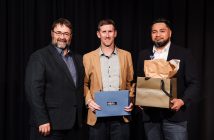A University of Canterbury master plan to guide campus development for the next 30 years proves the university has largely completed its earthquake recovery, according to Vice-Chancellor Dr Rod Carr.
ŌĆ£The plan is an exciting step, and tangible proof we are now very much looking forward into the future – one that will see UC with a bright, vibrant, modern campus that will lead the world in many aspects of its development,ŌĆØ Carr says.
The first stage of the master plan provides key projects and initiatives through to the universityŌĆÖs 150-year Jubilee in 2023. The second stage envisages the next 10 years through to 2045, and the third stage explores potential and identifies opportunities for expansion.
This is not a short-term vision, learning resources executive director Alex Hanlon insists. ŌĆ£ItŌĆÖs one that will guide campus development through to our jubilee and beyond,ŌĆØ he says. ŌĆ£Because of that, weŌĆÖve had to propose a staged development, and it has to be flexible of course ŌĆō because so much can happen over a 30-year time span.ŌĆØ
Through 2017 and 2018, three flagship projects will be completed at UC, creating┬Āsome of the most modern teaching, learning and research facilities in the southern hemisphere.
The fully refurbished Engineering precinct will see its first students at the start of 2017ŌĆÖs first semester, and the new Regional Science and Innovation Centre will open its doors mid-year.
When a completely renovated Rehua building opens its doors at the start of 2018, it will house the College of Education, Health and Human Development, along with some programmes from the Business and Law College.
ŌĆ£Once those buildings are open and students are reaping the benefits, it will really energise our campus,ŌĆØ Hanlon believes. ŌĆ£But in the meantime, we are working hard on finalising critical aspects of the masterplan, including transport, landscape and parking plans and a retail plan.ŌĆØ
Developed by UCŌĆÖs Learning Resources team, the plan involved a lengthy process of research, analysis and consultation to determine┬Āthe┬Āvalues, resources, habits and trends that would shape the planŌĆÖs final vision.
The plan has been developed to help the university achieve its strategic objectives of providing a unique and memorable campus experience, supporting innovative teaching and ground-breaking research, attracting increased number of students and encouraging ongoing engagement with the local community.
ŌĆ£It will provide a safe, secure, pleasant and inspirational environment where our community can explore, learn, discover, debate and grow,ŌĆØ Hanlon says.
ŌĆ£We started with the physical estate but then it was very much about how our spaces enable all the fantastic work that our university community does.
ŌĆ£From student events to high-end research facilities, UC is a little city inside a larger city. We had to consider how lots of different things relate to each other.ŌĆØ
Key themes emerged from a number of interactive workshops the team held with different stakeholder groups.
The same themes appeared again and again, and it was this input from the community itself that guided the underlying principles of the plan, Hanlon recalls. ŌĆ£People especially wanted a connected campus, one that encouraged interaction and inspiration around a strong and vibrant central hub that buzzes with activity.ŌĆØ
An open expression of culture was considered crucial to the project, and Ngāi Tūāhuriri worked closely with the Learning Resources team, providing a cultural narrative to ensure the values and aspirations of mana whenua are clearly visible and accessible in any future development.
┬Ā




